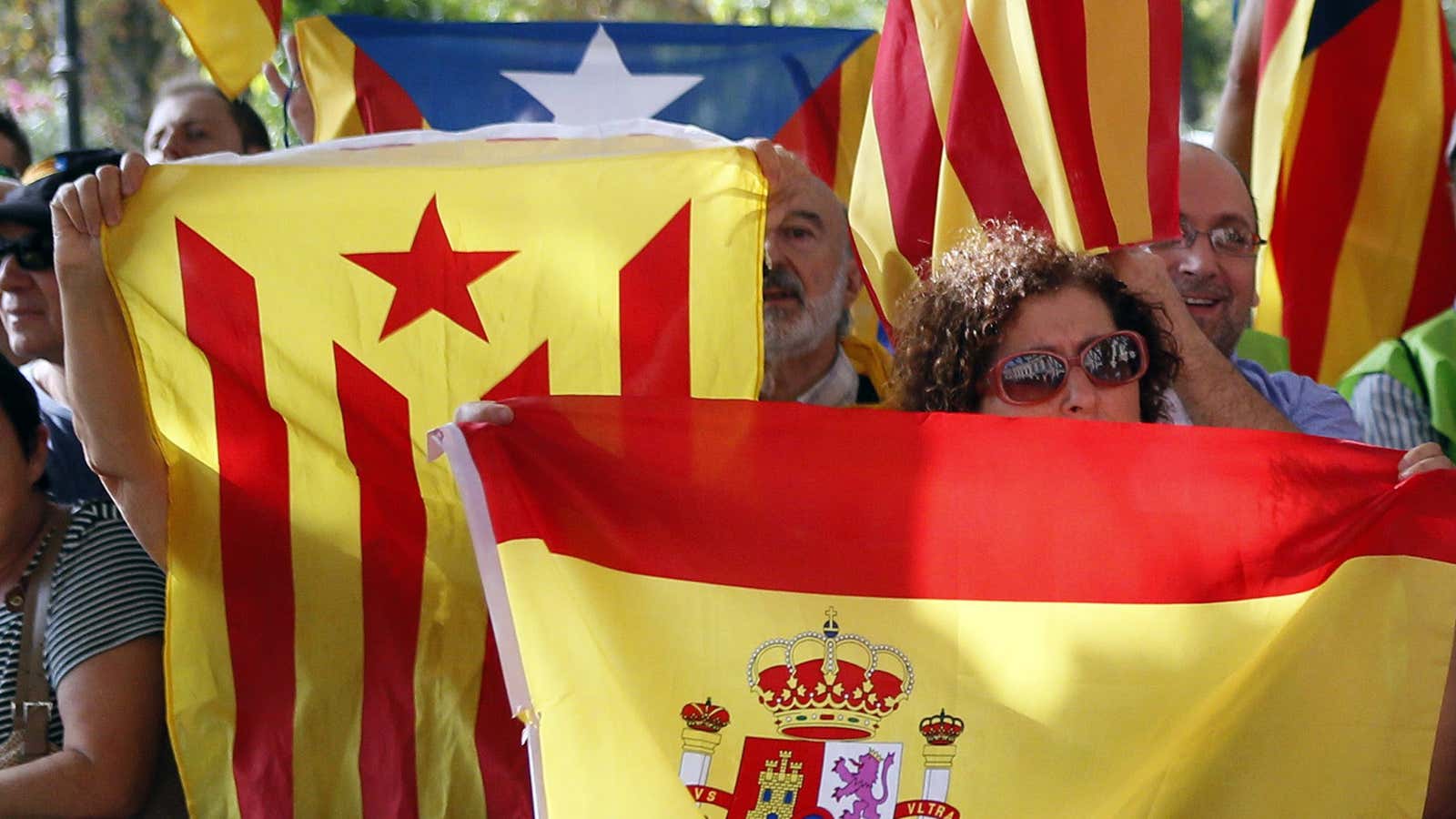Hoping to skirt both the inefficiencies and geopolitics involved in digitizing national symbols, the Unicode Consortium, the Silicon Valley nonprofit that makes emoji available to the world, said it will no longer entertain ideas for new emoji based on flag designs.
“The Unicode Consortium isn’t in the business of determining what is a country and what isn’t,” writes Jennifer Daniel, chair of Unicode’s emoji subcommittee, in a March 28 blog post. “If the Emoji Subcommittee recommends the addition of a Catalonia flag emoji, then it looks like favoritism unless all the other subdivisions of Spain are added. And if those are added, what about the subdivisions of Japan or Namibia, or the Cantons of Liechtenstein? The inclusion of new flags will always continue to emphasize the exclusion of others.”
In an email to Quartz, Daniel expounded on the technical challenge involved in accurately implementing country flags. “Flags are super hard to discern at emoji sizes and it’s quite easy to send a different flag than you intended,” says Daniel, an illustrator and creative director at Google.
Indeed, there are some flags that look indistinguishable at a quick glance (see Chad and Romania); and many designs are hard to implement at small sizes, like flags with a coat of arms or a pattern (see Turkmenistan).
“Any emoji additions have to take into consideration usage frequency, trade-offs with other choices, font file size, and the burden on developers (and users!) to make it easier to send and receive emoji,” Daniel says. “The simple truth is that if more people used flags, there would be more of an argument to encode them.”
Flags are the largest and least used emoji category
Of the 258 flags in the current global emoji set, only 10 are frequently used. The triangular red flag is the most popular, followed by the US flag and the rainbow flag. (The rankings in the graphic below were based on data collected in 2021, which wouldn’t factor in recent usage of the Ukrainian flag emoji 🇺🇦 , which has been in heavy rotation since the Russian invasion.)
Daniel hinted at Unicode’s thinking when she recently wrote about the overall unpopularity of country flags in Observable, a blog about data visualization. “This data is a strong signal to encode fewer specific concepts like flags and less single-use objects like shower caps and instead focus on globally-relevant, well established communicative concepts,” she argues.
The new policy contains an exception for future independent states affirmed by the United Nations. The flag of the country to follow South Sudan as the world’s newest nation will be automatically included in the emoji set, with no proposals needed, Daniel clarifies. And if an existing country flag is redesigned, like Mauritania’s in 2017, developers will make the updates to the corresponding emoji.
Questioning a Silicon Valley world view
Scott Mainwaring, a vexillologist and editor of the North American Vexillological Association (NAVA) academic journal Raven, laments Unicode’s hardline on flags. “I think it’s disappointing. There seems to be a resurgence of interest among younger people in flags to communicate identity,” he argues.
Mainwaring, who also handles NAVA’s social media strategy, says the passionate online community of flag enthusiasts didn’t have an inkling that Unicode’s decision was coming, until the group’s announcement on March 28. He remains unpersuaded by the consortium’s rationale and is left questioning the interests of the standards body, whose membership is largely comprised of representatives from big tech firms. “Last year, it came to light how there came to be a pickup truck emoji and turns out that Ford Motor Corporation funneled a lot of money in the background to have the Ford F-150 turned into an emoji,” he points out. “In the past, Taco Bell lobbied for the taco emoji and Tinder lobbied for the interracial couple emoji.”
Anyone—individuals, lobbyists, advocacy groups, and corporations—can propose a new emoji for free. The application requirements are laborious the emoji vetting process is “shadowy,” as the Los Angeles Times described it. Unicode reportedly reviews anywhere from 50 to 100 proposals each year.
“It’s important to have more accountability for the Unicode committee,” Mainwaring says.
Seemingly small decisions like prioritizing one set of emoji over others can shape global culture, contends Mainwaring. Because emoji began in Japan, there are understandably lots of symbols associated with Japanese culture. And so long as the locus of the tech industry remains in Silicon Valley, future emoji will likely reflect that particular lens on the world—because, as Mainwaring notes, “what’s important in Namibia will continue to be totally off the radar if all you’re looking at is the popularity of emoji.”
